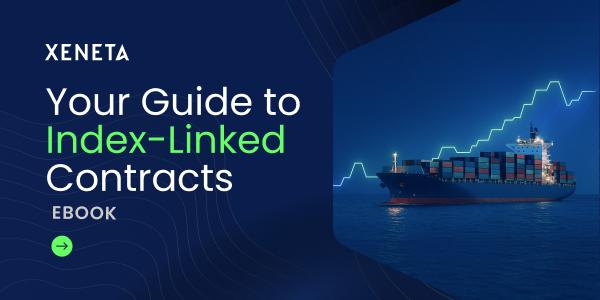With the first quarter of the year having sailed off over the horizon, it’s time to take a deep dive into Xeneta and Marine Benchmark’s Carbon Emissions Index (CEI) to assess the environmental performance of the carrier segment. Built on the foundation of real-time AIS data and individual vessel specifications, the CEI gives shippers the data they need to make informed “green shipping” decisions for their global cargoes.
So, in a challenging economic market for the ocean freight industry, how are carrier emissions evolving?
1. Efficiency gains on majority of major trades
Q1 2023 saw CEI improvements on the majority of Xeneta’s top 13 trades. The average CO2 emitted per ton of cargo carried fell on ten of the world’s leading trades compared to Q4 2022.
The biggest quarterly CEI ‘winner’ was the US West Coast to the Far East trade, where an 11.3% fall from Q4 2022 brought the score down to 88.0 points. Not only did the average size of ships deployed on this trade increase, while the filling factor stayed stable, but more importantly average speed decreased by almost 1 knot.
The three trades that recorded an increase in average CO2 emissions, and therefore an increase in CEI, were North Europe to the Far East and to the US East Coast, and from the Mediterranean to the US East Coast.
2. Speed and filling factors drive developments
Just as speed was critical to the improvement in the CEI from the US West Coast to the Far East, it was also a pivotal factor in developments elsewhere.
As carriers deal with overcapacity, we have seen several alliances add capacity to services and slow down the speeds of deployed ships. By doing so they can avoid these extra vessels adding to the actual capacity offered. In fact, there are only three trades that have a faster average sailing speed in Q1 2023 than they did in Q1 2022. These are all fronthaul trades; two from the Far East to North Europe and to the US East Coast, and from North Europe to the US East Coast. The biggest drop in average speed compared to a year ago was registered from North Europe to the South American East Coast, where it was down by 17.6%, moving from 17.3 knots in Q1 2022 to 14.3 knots in Q1 2023.
The filling factor has also stabilized across the top 13 trades over the first quarter of the year. Between Q3 2022 and Q4 2022 the average filling factor fell by 3.5 percentage points, with only three trades avoiding a drop, whereas in Q1 2023 the average drop in filling factor was down to one percentage point.
In contrast to the previous quarter, all trades out of the Far East saw a slight increase in their filling factor, up by between 0.1 percentage points (to the South American East Coast) and 5.3 percentage points (to North Europe).
Trades out of North Europe saw the biggest drops in filling factor, with the steepest decline coming on the North Europe to US East Coast trade, which fell by 8.8%.
3. Not all trades are moving in the right direction, as industry aims accelerate
Developments across the top trades have been far from uniform since the introduction of the CEI in Q1 2018. The star performer has been the Far East to the US East Coast corridor, with a 21.2% improvement between Q1 2018 and Q1 2023, while the Mediterranean to US East Coast trade is at the opposite end of the scale, with a 13.6% higher CEI for the same period.
There were four trades recording a worse CEI in Q1 2023 than in Q1 2018, scoring between 102 and 113.6 points. All the trades with a CEI above 100 have at some stage in the past six years scored below this benchmark (an improvement from Q1 2018), before seeing their average performance deteriorate.
There is good news for the many exporters out of the Far East, with the top five trades from the region all showing improvements over Q1 2018. None of these trades had a CEI above 91 - in other words, an improvement of at least 9% since the index was introduced. In fact, the last time a trade out of the Far East registered a CEI of over 100 was back in Q4 2021, when the Far East to US West Coast trade, plagued by congestion and delays, rose to 101.9 points.
The 80th MEPC, the International Maritime Organization’s (IMO) climate summit, held last week, agreed new targets for decarbonizing shipping. The new headline targets are to reach a 20% reduction in total maritime emissions by 2030, a 70% reduction by 2040 and to hit net-zero by 2050.
While these targets cannot be compared directly to the CEI, as they measure two different things - and the IMO’s baseline is set in 2008 rather than in 2018 - there is still a lot of work to be done for the container shipping industry to achieve these ambitious goals.
4. Yang Ming takes emissions crown
In Q1 2023, Yang Ming was the carrier which held the top spot on the greatest number of the top thirteen trades. It was the cleanest carrier (when measured by CO2 emitted per ton of cargo carried) on three trades, with OOCL and HMM securing the top spot on two trades a piece.
Yang Ming was the only major carrier to score below the trade lane average on all the trades where it deployed ships, with CEIs ranging from 58.3 to 80.4 points. Yang Ming also deployed younger ships than the trade lane averages and, importantly, sailed slower.
With the exception of the Far East to the South American East Coast, where Yang Ming sailed 0.6 knots faster than the trade lane average, Yang Ming’s ships were between 0.9 and 3.2 knots slower than competing carriers on the other major trades.
5. Operational decisions can have major impacts on environmental performance
While some carriers like Yang Ming consistently outperform the trade lane average on all the trades where they operate, others have much larger variations in their CEI scores. A clear example of this is CMA CGM, which had ships deployed on all the top 13 trades in Q1 2023. On eleven of these, CMA CGM’s CEI score was below the trade lane average, by between 2% and 15.2%. However, on the two trades where CMA CGM scored higher than the average there was a noticeable disparity.
For example, from North Europe to the South American East Coast CMA CGM scored a CEI of 189.5, an eye-catching 85.9% worse than the trade lane average. This can be explained by the fact that the carrier deploys much smaller ships on this trade, with an average capacity of just 2 200 TEU, compared to average vessel sizes of at least 7 000 TEU on other major trades.
In this respect we can see how operational decisions concerning fleet deployment can have huge consequences for a carrier’s environmental performance on different trades. Shippers looking to address the carbon footprints of their own logistics chains should be aware of these factors when choosing where to allocate their volumes on individual trades.
Get an honest view of carrier emissions
Stay one step ahead of your competitors by making well-informed and sustainable choices when selecting shipping carriers. Xeneta and Marine Benchmark offer an independent and trustworthy Carbon Emissions Index (CEI) data, ensuring accuracy without any guesswork. By utilizing AIS tracking of real-time sailings on 48 major trade routes worldwide, with coverage expanding further in the near future, you can rely on up-to-date information. Don't settle for outdated and unreliable data. Schedule a demo of the CEI today and begin making intelligent shipping decisions. Get a demo here.
%201.png)



.png?width=978&height=579&name=image%20(5).png)

